Understanding the framework of the Australian government, how it is structured, formed and functions is key to advocating for change and the preservation of our Constitutional rights of freedom and liberty.
Take a few hours to educate yourself
In 2020 I took a couple of days wading through the Australian government websites informing myself on how our political and governmental system is structured and functions. Embarrassingly too much of this I didn’t know, they didn’t teach this to me in school and my parents assumed the school would teach me!
Putting together the timeline is helping to build the picture of the historical, incremental changes that led up to the present day over-reaching government control of free people. We the people let this happen, and now it is time for we the people take back democratic control, and remove dictatorial mandates!
The 1901 data point on the pre-pandemic timeline is the founding of The Australian Constitution. This point reinforces that our government representatives are servants of the people not the other way around. But in order for them to serve you, the electorate representatives need to know the views and opinions of their constituents for them to represent you in Parliament. That means, you, me and everyone needs to contact them our state and federal representatives and voice our views and our will.
People need to educate themselves in how the government is structured so they know how to step in, take action and affect the change they want to happen. This page is to help get you started. The more people who understand this, the greater our chances of up holding our freedoms.
It’s time to set a side a few hours to educate yourself. You might think it is a boring and complicated topic, maybe it is for most of us, but it is essential we take the time to try understand the Australian political framework.
7 minute Overview of the Australian Political System
How can politicians represent their constituents if they don’t know their issues and concerns?
It is our duty to let our state and federal representative know our views. But do you even know who these are, and what their role is. We need Australian citizens educated in all things government and law, especially at this pivotal time in our history when our bodily freedoms, and our freedoms to move about are being threatened with over-reaching controls.
Taking action is not about getting involved in politics (unless you are that way inclined) it is about stepping up and voicing your opinion to your local state and federal political representative. If you don’t tell them your view, how will they know? Government representatives are elected by the people, they want to keep their job, we need to hold them accountable for their actions or in-actions, especially after we have let them know our view.
We The People have all the Power.
By understanding how our government is structured, formed and functions you will realise just how much power that we the people really have. That power is harnessed when enough of us step up and take action and let our representatives know our concerns.
This assertive activism especially needed at this point in our history.
Our children and future generations depend on us taking action now.
Everyone has to step up and take action, it can’t be left to a few to “fight”, everyone who cares about their freedoms needs to pitch in and help. Sitting around trusting the government is not going to ensure Freedom of Choice for you, your children or the generations to come.
What powerful actions can people take:
- Educate yourself and others
- Make contact with your local political representative
- Writing letters or emails to your representatives, ask questions, state your will or thank them for their good work
- Phone politicians and Ministers
- Submit Freedom of Information (FOI) requests
- Activism and educating the public – protests, marches, lobby, letterbox drops
- Social media activism and engagement (where possible)
- Form a new independent political party
The more of us getting involved the more impact it will have.
If your MP is not supporting your views, make your vote count in the upcoming election.
Don’t wait, get started taking action today!
Looking for a place to start?
An automated email dissemination system has been set up at Vaccine Choice Australia, to send letters to your local representative with the ease of a few clicks. Write your own words, the system automatically sends it to the right email address. Like they too, your MP “can’t represent you properly if you’re not communicating how you feel on issues” with them.
The Australian Government
Brief Overview of structure and terminology
These notes that follow are intended to summarise the state and federal government structure and purpose to give a foundation for your learning.
Be aware that Local government (such as councils) are not mentioned in The Constitution, and are not discussed here.
State governments have their own constitution and function similarly to the Federal structure. This section focus’ on the federal government.
The government is elected by the people, they are public servants.
The Constitution of Australia (1901)
The Australian Constitution established a framework for the governing institutions; prescribing the powers of the Federal Parliament to make laws and created a Federal Judiciary to uphold them.
The Australian Constitution framework for the main political institutions:
- Legislative Power to make laws
- Executive Power to carry out and enforce these laws
- Judicial Power to interpret laws and apply them
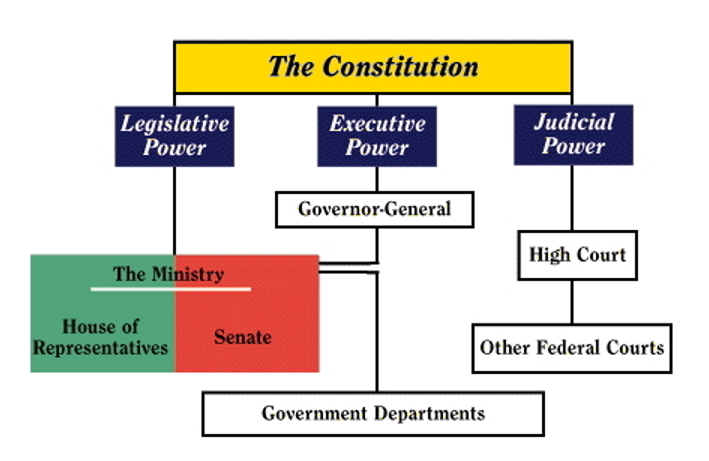
1. Legislative Power
The Parliament in Canberra is made up of the House of Representatives and the Senate, these two bodies make laws or stop bills from passing into law.
House of Representatives
The House of Representatives is referred to as the Lower House. It is made up of 151 Members of Parliament (MPs) from Electorates right across Australia. They are elected by their Electorate’s constituents and hold office for a period of 3 years.
Electorates are physically different in area, but are divided such that each electorate represents a somewhat equal number of registered voters. As populations change, the electorate borders defining the region can change.
Each MP has their own office in their Electorate, where their constituents can meet with them, or post them mail. The MP’s travels to Canberra whenever Parliament sits so they can be a spokesperson for their constituents, and represent their electorate’s dominant view.
The Senate
The second house is the Senate made up of 75 Members, 12 elected from each state (6 year terms) and 2 from each territory (3 year terms) of Australia, so the States enjoy equal representation in the Senate, regardless of their population.
The modern Senate is a very powerful Chamber. Bills cannot become law unless they are agreed to in the same terms by each House, except in the rare circumstances of a double dissolution followed by a joint sitting of both the houses.
Senators spend much of their time on Senate committee work.
2. Executive Power
The Governor-General
The Executive is the Governor-General of Australia, who by convention under the Constitution, must appoint the parliamentary leader of the party, or coalition of parties, which has a majority of seats in the House of Representatives. Though in actuality it is the majority party that wins government that elects their leader and the Govenor-General give it their stamp of approval.
The Govenor-General is the representative of the British monarch for Australia and is appointed by the monarch, again on the recommendation of government ministers. This position appears largely ceremonial. Where Ambassadors, Ministers and Judges said to be appointed by by the Govenor-General, it is actually the Prime Minister who advises who they would like appointed into these positions and the GG signs off on it.
The Federal Executive Council, referred to in the constitution, comprises all ministers, with the Governor-General presiding. Its principal functions are to receive ministerial advice and approve the signing of formal documents such as proclamations, regulations, ordinances and statutory appointments.
Australia operates under a Cabinet system of government. The Cabinet, not mentioned in the Constitution, is the key decision-making body of the government and comprises senior Government Ministers. The decisions of Cabinet are given legal effect by their formal ratification by the Federal Executive Council.
The Prime Minister
The Prime Minister is the leader of the Party or Coalition that has the majority MPs to form Government. The Government being the majority of the House of Representatives – those who represent the people of Australia. The PM is also the leader of The Cabinet being the selected MP’s which direct policy and make decision about national issues.
A Coalition occurs when two or more political parties enter into a formal agreement to cooperate with a view to achieving a majority in parliament. The need for coalitions arises because this is not always possible under Australia’s preferential voting system. Under the preferential system, voters number candidates on the ballot paper in a rank order of choice.
The PM is also the leader of The Cabinet who are Members of Parliament that direct policy and make decision about national issues.
Interestingly the role of the Cabinet government nor the Prime Minister is nowhere mentioned in the Constitution. They are customary offices. Whoever can form a government and command the confidence of Parliament rules.
3. Judicial Power
The Judicial system is the final political institution to govern the people of Australia.
The High Court of Australia is the Supreme court with respect to hierarchy. It has the power of judicial review of laws passed by the parliament of Australia and the parliament of each State, and it’s role is to also interpret the Constitution of Australia.
Proposed legislation has to be passed successfully by both the House and Senate to become law, if there is a disagreement between the two then a piece of legislation will be held up indefinitely.
Formation of a Government
To form a government, the majority must hold at least 76 seats in the House of Representatives out of 151 Electorates. The government selects their leader who becomes the Prime Minister, the people of Australia do not elect the Prime Minister.
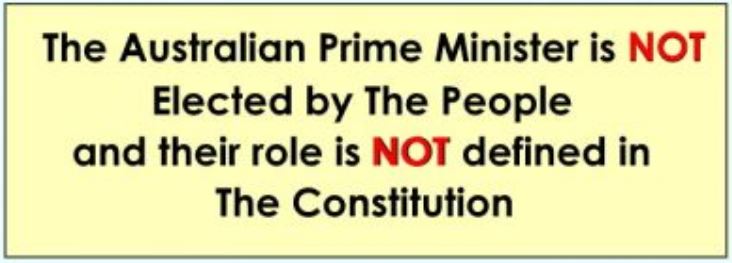
Elections
Federal Elections can be called any time by the Prime Minister, but they must be held at least every 3 years.
Federal elections elect both House Representative (Electorate members) and Senators.
A hung parliament is when neither party has enough seats to form a majority. As more independent candidates enter the electoral race, the people may choose them over the traditional two party candidates, and as such will become harder for a Party government to form. This is especially true in the current climate where our existing government is passing unprecedented control on the population, so to make change, the people are stepping up to volunteer to run for a House of Representative’s position.
Frontbenches, Backbenches and Crossbenches
When parliament sits, the Members are arranged in a specific manner around the U-shaped bench structure referred to as frontbenchers, backbenchers, and crossbenchers. These members are made up of the Government (majority party) and on the opposite side the Opposition or Shadow Government, as well as the minority parties and independents.
- Frontbenches – members of parliament who sit on the front seats of either the Senate or House of Representatives
- Backbenches – members of parliament who sit in the rows of seats behind the frontbench
- Crossbenches – independent or minority party member of parliament
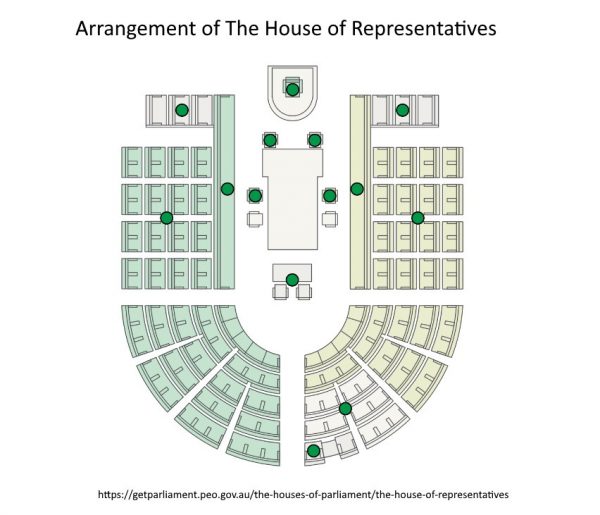
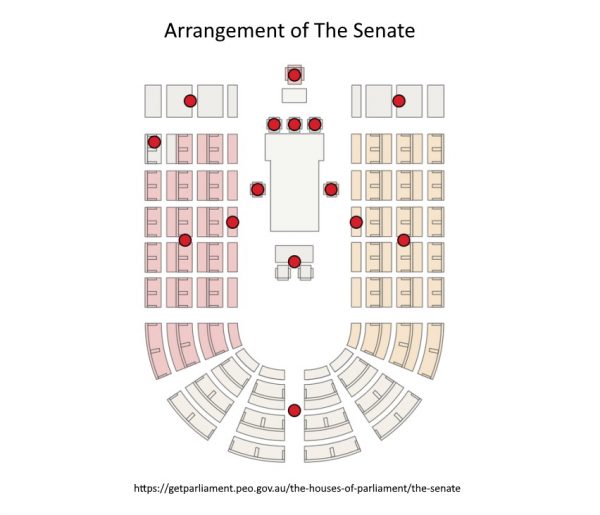
Frontbenchers
Ministers and shadow ministers (opposition party) sit on the front row of the seats in either the House of Representatives or the Senate. Government frontbenchers are ministers who have been allocated a portfolio. In the Senate and House, the role of a minister includes introducing bills and answering questions about their portfolio during Question Time. Their portfolio being an area of government that the minister is responsible for over seeing, i.e. Health, Transport, etc.
Backbenchers
Most of the work conducted in the Senate and House relates to debating and voting on bills. Backbenchers also draw attention to their electorate or state and territory issues by speaking about them in Parliament.
Crossbenchers
As independent or minor party members they have the role to represent their electorate in parliament, it’s simply they are not affiliated with the 2 major parties.
Two Party System
The Australian political system is described as the two party system between Liberal National Party (coalition) and Australian Labour Party, though this is not defined or part of the Constitution.
- Labour is considered Centre-Left
- Liberal is considered Centre-Right
In parliament the government is meant to represent the people, but often they represent their party and no necessarily the views of the people. This could be a major reason why we have seen in recent years, more and more independent parties winning seats in parliament.
Anyone can register for and form a Political Party, they just need to meet the criteria set out by the Australian Electoral Commission.
Voting in an Election
In Australia it is compulsory to vote once you turn 18. On election day the HoR ballots are hand counted, but in 2016 the Senate voting system was changed to include computer scanning followed by data operator verification.
Are our elections secure?
Does that data operator have the option of changing a vote? Why did we move away from hand counting alone? What happened in the 2020 US Election which computers systems makes this concerning. At the end of the day vulnerabilities do exist!
In some State elections electronic voting and electronic counting is allowed, as well as online voting. Ownership of iVote is by Scytl Australia Ltd a subsidiary of a Spanish company – international ownership.
The Ballot Papers
In a Federal Election there are two ballot papers, one for the House of Representatives and one for the Senate. Examples below:
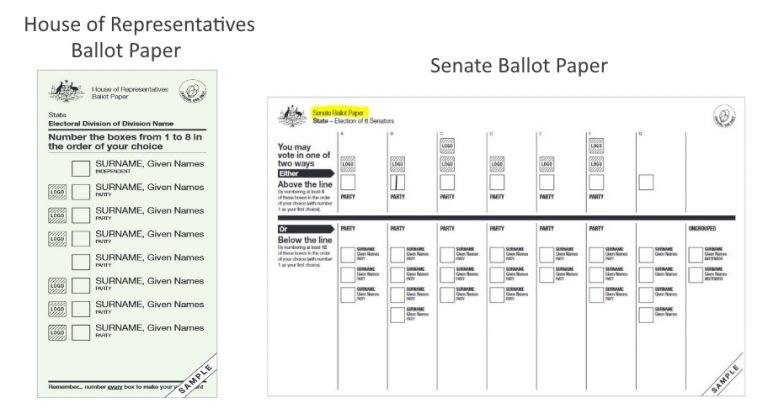
The ballots are marked according to the directions given on each ballot, and are counted using the preferential system.
Counting Preferential Voting
A quick video showing you how the preferential voting system works:
If the above video is not clear, then try this video where they demonstrate the counting process.
As you can see with preferential voting, the candidates you least want to get in need to be the highest number.
Which electorates can swing an election and how?
The following video explains the importance of marginal seats, and how the politicians can “hoodwink” the electors into voting for them. We the people need to become more savvy to their tricks and find candidates that better represent our will and less of their party.

